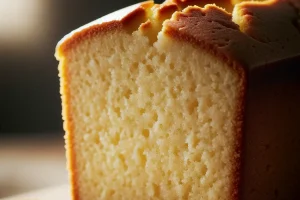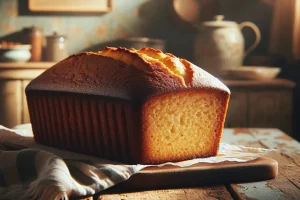In the realm of classic desserts, few stand as timelessly beloved as the pound cake. For a deeper understanding of its culinary significance, The Culinary Institute of America (CIA) offers a wealth of knowledge on traditional baking arts. With its rich history and simple elegance, the pound cake stands as a testament to baking’s timeless allure, this delightful treat has captured the hearts of dessert lovers for centuries. In this comprehensive exploration, we’ll delve deep into the essence of pound cake, from its humble beginnings to the diverse world of flavors and presentations it encompasses today. We’ll also tackle some of the most common quandaries bakers face, such as the perennial question, “What made my pound cake dry?” So, preheat your ovens and ready your taste buds as we embark on a flavorful journey through the world of pound cake.
Introduction to Pound Cake
The Essence of Pound Cake
Pound cake is a testament to the beauty found in simplicity, symbolizing the core values of traditional baking. Originating from a time when baking was an art guided by memory and practice rather than precise measurements, the pound cake gets its name from the traditional use of a pound each of four key ingredients: flour, butter, eggs, and sugar. This equal-ratio formula was easy to remember, making the pound cake a staple in many kitchens.
A Brief History
The origins of pound cake lie in the European baking traditions of the early 1700s, weaving a rich tapestry of culinary heritage. Consequently, it was a practical recipe that could be easily memorized and adapted, making it popular among home bakers and professional chefs alike. Furthermore, as the recipe crossed oceans and borders, it took on new forms, absorbing local flavors and ingredients along the way.
Why “Pound” Cake?
The name “pound cake” might seem like a nod to the cake’s weight, but it’s actually a reference to its original recipe – a pound each of flour, butter, eggs, and sugar. This straightforward formula ensured that even the most novice of bakers could whip up a cake with ease.
Evolution Over Time
As baking techniques and ingredient availability have evolved, so too has baking adapted and flourished with each new innovation. From the incorporation of leavening agents like baking powder to the introduction of creams and flavorings, this dessert has transformed into a versatile canvas for culinary creativity. Yet, at its core, it remains a celebration of balance and simplicity in baking.
One common challenge many bakers face is ensuring their pound cake remains moist and tender. So, you might wonder, “What made my pound cake dry?” Often, the culprit is overbaking or too much flour. Achieving the perfect texture requires a careful balance of ingredients and timing, a skill that comes with practice and patience.
As we continue our exploration of pound cake, we’ll dive deeper into the nuances of crafting the perfect slice. Additionally, from choosing the right ingredients to mastering the art of presentation, we’ll uncover the secrets to elevating this classic dessert to new heights. Stay tuned for more insights and tips.

The Classic Recipe
Crafting the quintessential pound cake is akin to performing a delicate dance in the kitchen, where each ingredient and step plays a pivotal role. Consequently, with each step meticulously measured and every ingredient harmoniously blended, the result is a masterpiece of buttery, velvety goodness that stands as a testament to the timeless allure of classic desserts. Now, let’s embark on the culinary journey of creating the perfect pound cake, guiding you through each ingredient and step with the finesse of a seasoned baker.
Crafting the Perfect Pound Cake
At the heart of every great pound cake, lies a symphony of simple, yet high-quality ingredients. Notably, each plays a vital role in the cake’s final texture and flavor, consequently ensuring a delightful culinary experience with every bite.
Ingredients Overview
- Flour: The foundation of our cake, all-purpose flour works wonders, providing structure while keeping the crumb tender.
- Butter: Opt for unsalted butter at room temperature; it’s the secret to that melt-in-your-mouth richness.
- Sugar: Fine granulated sugar not only sweetens but also aerates the butter, contributing to a fine crumb.
- Eggs: Large, room-temperature eggs bind the mixture, adding moisture and lift to the cake.
Step-by-Step Recipe
- Preparation: Begin by preheating your oven to 350°F (175°C) and meticulously greasing and flouring your baking pan.
- Creaming Butter and Sugar: Whip the butter until creamy, then gradually add sugar, beating until the mixture is pale and fluffy. This process incorporates air, a critical step for a light cake.
- Egg Integration: Add eggs one at a time, fully incorporating each before adding the next, to ensure a smooth batter.
- Dry Ingredients: Sift the flour and gently fold it into the wet mixture in batches, taking care not to overmix and deflate the batter.
- Baking: Pour the batter into the prepared pan and smooth the top. Bake until a tester inserted into the center comes out clean, usually about 60-70 minutes. Remember, patience is key; too eager a peek can lead to a fallen cake.
Tips for Perfection
- Room Temperature Ingredients: Ensure your butter, eggs, and any other refrigerated items are at room temperature to facilitate a smoother blend.
- Don’t Rush the Creaming: Adequate creaming of butter and sugar is non-negotiable. It’s what gives the cake its fine crumb and height.
- Sift, Sift, Sift: Sifting the flour not only removes lumps but also aerates it, making for a lighter cake.
- Bake with Love: Keep an eye on your cake, but resist the temptation to open the oven door too often. Steady heat is crucial for an even rise.
Crafting the perfect pound cake is an exercise in patience and precision. From the careful creaming of butter and sugar to the gentle folding of flour, every step is a building block to achieving that classic, buttery pound cake we all cherish. So, roll up your sleeves and let the comforting aroma of baking fill your kitchen, as you bring to life a dessert that’s as rewarding to make as it is to savor.



